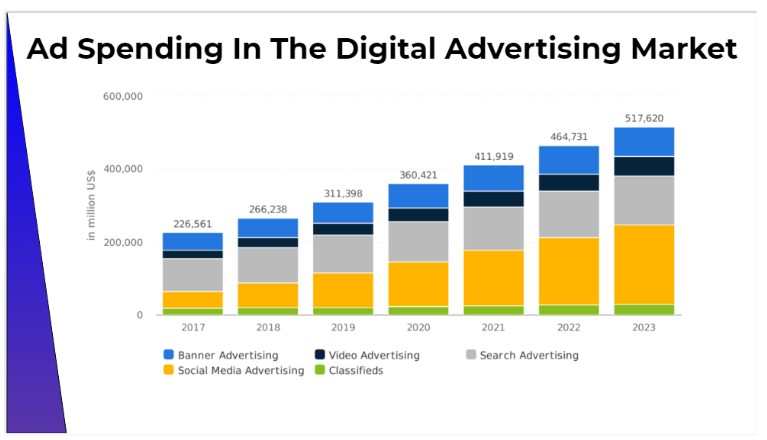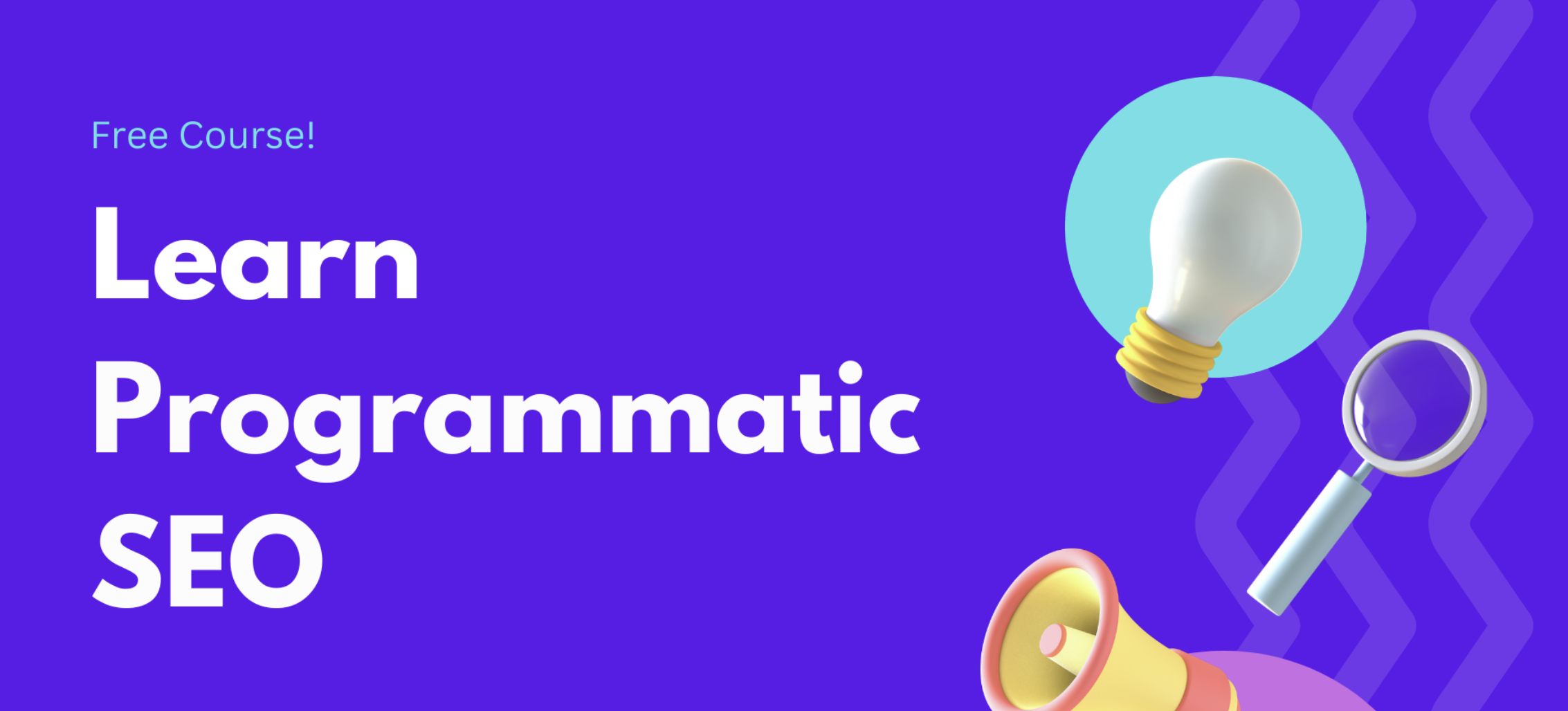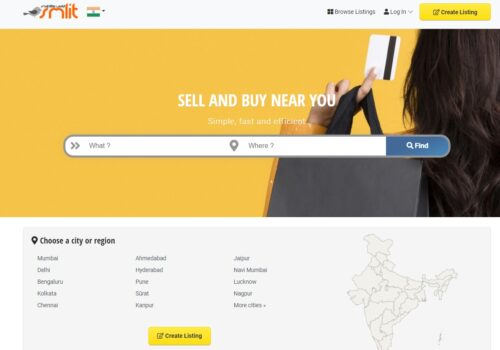Hello there! Selling advertisements for your website might sound complicated, but it’s easier than you think.
Many website owners wonder where to find advertisers and how much they can make from it.
The global digital advertising spending is projected to reach $646 billion by 2024. 🤷♂️
In this article, I’ll show you proven strategies and easy ways to effectively sell advertising on your website.
Did you know that websites with display ads earn an average of $0.75 to $2.00 per 1,000 visitors? That’s a great opportunity to boost your earnings!
So, let’s explore how you can tap into the advertising potential of your website and maximize your profits. It’s simpler than you think, and I’m here to guide you every step of the way.
Let’s get started and unlock the earning power of your website, starting from the basics. 🔥
What is ad space?
Ad space is like real estate on your website where advertisers can place their ads. As a website owner, you decide where these ads will appear, such as at the top, bottom, sidebar, or within articles.
There are various types of ads you can showcase, like Banners, Native Ads, and Push Ads, depending on your preference.
I became an Adsterra publisher, and it’s been fantastic! Regardless of my traffic level, I got access to over 13,000 reputable advertisers.
A number of website-friendly ad formats are available through Adsterra, including Native Banners, Popunders, and Social Bars, which have significantly increased my revenue. It’s a win-win situation for both my website and the advertisers!
What does selling ad space mean?
Allocating ad space on my website was simple, but I realized it wouldn’t be beneficial if no one advertised on it. So, I decided to sell ad space to third parties who wanted to reach my audience.
I explored two options: selling the space directly to advertisers or using an ad network as an intermediary. I chose Adsterra as my ad network because they have a wide range of reputable advertisers and their platform is user-friendly.
With Adsterra, I can maximize my ad revenue and easily manage my ad space, making the process hassle-free!
Selling ad space: how it works
Selling directly to advertisers: In this method, you reach out to brands and businesses that are relevant to your target audience and pitch them to buy ads on your website.
Selling directly to advertisers can potentially earn you higher revenue since there are no intermediary fees. However, it can be challenging as it requires finding willing advertisers, negotiating deals, and managing the entire process on your own.
Selling via an ad network: Alternatively, you can choose to work with an ad network. An ad network acts as an intermediary between you and the advertisers.
The network already has a pool of advertisers, and you can sign up with them to connect with potential advertisers. The advantage of using an ad network is that they handle the difficult part of finding advertisers for you.
However, keep in mind that the ad network will collect a fee or commission on your ad revenue as compensation for their services.
Each approach has its pros and cons, and the right choice depends on your preferences, resources, and goals as a website owner.
Some publishers prefer the direct approach for higher control and potential revenue, while others opt for ad networks for their convenience and access to a broader advertiser base.
It’s essential to weigh these factors and decide which method aligns better with your website’s needs and objectives.
Basic requirements for selling ads
Meeting specific requirements is crucial to attract advertisers for your website.
Firstly, having good traffic is essential because brands want to reach an engaged audience. While you don’t need very large traffic, having thousands of monthly visitors is a good starting point.
The great thing is that ad networks like Adsterra don’t have minimum traffic requirements, allowing you to start small and grow your earnings as your traffic increases.
Next, high-quality content is a must. Put yourself in your target audience’s shoes and create content that people want to read and watch. Keep your posts simple, factual, and avoid using verbose or boring language.
Your website’s design and usability play a significant role in attracting advertisers. Ensure your website has an intuitive interface with a visible navigation bar and clear indicators for easy navigation.
Having a menu with links to all post categories is also helpful. Use attractive colors, fonts, and high-quality visuals like images, videos, and infographics to make your website visually appealing.
Building a loyal audience that engages with your posts is vital. Having a smaller but engaged audience is better than having a large but disengaged one. Engaging readers are more likely to interact with ads, increasing ad monetization.
Transparency is key when dealing with potential advertisers. Provide factual information about your website’s traffic level, page views, social media following, brand appeal, and more.
Being open about your site’s strengths and weaknesses builds trust with advertisers.
As an example, Adsterra is an ad network that supports website-friendly ad formats, including Popunders, Native Banners, and Social Bar, helping you generate significant revenue. They have no minimum traffic requirements, making it accessible for publishers of all levels.
When selling ad space, there are various approaches you can take. One option is to sell directly to potential advertisers, pitching to them without the need for an intermediary.
While this approach may require effort and persistence, it allows you to keep all your revenue.
So, by meeting these requirements and using effective selling strategies, you can effectively sell advertising on your website and generate passive income.
Remember to focus on providing value to your audience and maintaining transparency with potential advertisers to build a successful advertising model for your website.
Pros
- Retain 100% of your revenue with no third-party cuts.
- Set your own advertising rates and find willing advertisers.
- Build long-term relationships with advertisers for lucrative deals.
- More control over your ad inventory and when to display ads.
Cons:
- Difficult to find and negotiate with advertisers individually.
- Best suited for sites with massive traffic and a unique audience.
- May require employing a sales team, adding overhead costs.
Affiliate advertising
This method is a fantastic way to make money through your website!
You basically promote products or services, and when someone buys them using the special link you provide, you get a percentage of the sale. It’s like earning a commission for every successful referral!
The best part is that you get a unique tracking ID, so the brand knows it’s all thanks to your website. So, the more people who click on your link and make a purchase, the more money you can earn! It’s a win-win situation for both you and the brand.
Pros:
- High earnings potential, up to 30% commission on each sale referred from your site.
- Easy to start with minimal requirements and numerous affiliate marketing networks available.
- A text-based affiliate link offers less distraction than an image or video-based display ad.
Cons:
- Payment is dependent on product purchases, no purchase means no pay.
- Highly competitive industry with many publishers competing for limited advertising dollars.
- Identifying the right products to promote can be challenging.
The 80/20 rule for affiliate marketing
In affiliate marketing, the 80/20 rule, or the Pareto Principle, means that 80% of the results come from just 20% of the effort. This means that a small percentage of affiliate marketers are the most successful and earn the most profits.
To break it down further, 80% of affiliate publishers get paid when someone makes a purchase through their affiliate link. So, they only earn money when a sale happens.
For example, if I promote a product on my website and someone clicks on my affiliate link to buy it, I get a commission from that sale.
The next 18% of affiliate publishers get paid for suggested actions, like when someone adds an item to their cart but may not necessarily complete the purchase. This type of commission is based on specific actions taken by the user, not just the final sale.
Finally, the remaining 2% of affiliate publishers earn money through cost-per-mille or cost-per-click.
Cost-per-mille means they get paid for every thousand views their affiliate link receives, while cost-per-click means they get paid each time someone clicks on their affiliate link, regardless of whether they make a purchase or not.
How does affiliate marketing work?
Using affiliate marketing, individuals (affiliates) promote other companies’ products or services for a commission.
It operates on a revenue-sharing model, meaning affiliates receive a percentage of the revenue generated from their promotional efforts.
Here’s how it works:
- Affiliate Selection: Companies that want to sell their products or services through affiliate marketing create affiliate programs. Affiliates then sign up for these programs to become partners.
- Promotion: Affiliates promote the company’s products or services through various channels, such as their website, blog, social media, email marketing, or YouTube. They use unique affiliate links or tracking codes to identify the traffic and sales generated through their efforts.
- Consumer Interaction: When a potential customer clicks on an affiliate link and visits the company’s website, a tracking cookie is placed on their browser. This cookie tracks the customer’s activity and ensures that the affiliate gets credited for any purchase made during that session.
- Conversion: If the customer makes a purchase or completes a specific action (like signing up for a newsletter or filling out a form), the affiliate earns a commission on that sale or action.
- Commission Payment: Affiliate networks or the company itself track the affiliate’s performance and calculate the commission owed to them. The affiliate receives payment either on a set schedule or when they reach a minimum threshold.
Example: Let’s say John runs a popular food blog and joins an affiliate program for a kitchen gadget company. He writes a blog post reviewing their latest blender and includes an affiliate link.
Sarah, a reader of John’s blog, clicks on the link, is redirected to the blender’s product page, and decides to purchase it. As a result, John earns a commission from the company for driving the sale.
Affiliate marketing benefits both companies and affiliates. As affiliate marketers promote products and services they believe in, they earn passive income while increasing sales and reaching a wider audience.
-
Ad networks
Ad networks have been a lifesaver for me as a website owner. When I started my website, I had limited time and resources to reach out to multiple brands for advertising opportunities.
It was challenging to attract advertisers on my own while trying to focus on creating quality content for my audience.
Thankfully, ad networks came to the rescue! They provide a single platform that connects publishers like me to various advertisers. Instead of spending countless hours pitching directly to brands, I can now easily link up with advertisers through the ad network.
The best part is that ad networks handle the tougher part of courting advertisers, saving me valuable time and effort. I no longer have to worry about negotiating deals or finding the right brands for my website. The network takes care of all that for me.
Thanks to ad networks, I can now focus more on creating engaging content for my readers and leave the advertising aspect to the experts. It’s a win-win situation that allows me to monetize my website effectively without the added stress and hassle.
What is an ad network?
As an expert in the advertising industry, let me explain how ad networks work. Ad networks serve as a marketplace that connects advertisers with website publishers.
They match available ad slots on publishers’ websites with ad inventory from various brands and businesses.
Here’s an example of how it works: Imagine Google wants to advertise on Bloomberg, a well-known financial news site. Google will approach an ad network and specify the type of ad they want to display, such as a banner or a text ad.
The ad network then finds available ad slots on Bloomberg’s website that match Google’s criteria.
There are different ways advertisers can pay for their ads through the ad network. One option is Cost-per-action (CPA), where the advertiser pays for every desired user action, like signing up or subscribing to a service.
Another option is Cost-per-click (CPC), where the advertiser pays for each click their ad receives. Lastly, there’s Cost-per-mille (CPM), where the advertiser pays for every thousand ad views.
When an ad is displayed on Bloomberg through the ad network, Google will be charged based on the chosen payment model (CPA, CPC, or CPM).
The ad network takes a percentage of this transaction as its fee and passes the rest of the payment to Bloomberg as the publisher.
This way, advertisers can reach their target audience through various publishers’ websites, and publishers can monetize their website traffic by displaying relevant ads from brands and businesses.
Ad networks play a crucial role in making this process seamless and efficient for all parties involved.
Why are ad networks needed?
Ad networks play a crucial role in connecting the right advertisers with the right publishers. For website owners, this is incredibly beneficial as it helps them find advertisers that are relevant to their target audience.
Without ad networks, the process of finding suitable advertisers would be random and complicated.
Moreover, ad networks take on the responsibility of negotiating ad rates on behalf of their publishers. This takes a major burden off the website owners, as they don’t have to engage in individual negotiations with each advertiser.
Ad networks have the expertise and experience to secure competitive rates that benefit both the publisher and the advertiser.
Another important function of ad networks is to screen the advertisements before they are displayed on the publisher’s website.
This ensures that the ads are safe and comply with the website’s content guidelines. By doing so, ad networks help maintain the credibility and safety of the publisher’s platform.
-
Native advertising
Native ads are a unique ad format that you’ll often find in various ad networks. What sets them apart is their seamless integration with the content, making them look like a natural part of the website.
In fact, they blend in so well that readers may not even realize they’re looking at an advertisement. This aspect of native ads is truly advantageous.
The main benefit of using native ads is that they are less disruptive to the user experience. With ad fatigue becoming increasingly common among internet users, it’s crucial to find advertising methods that don’t annoy or interrupt your readers.
Native ads offer the perfect solution as they allow you to earn money from your website while causing minimal disruption to your audience.
Compared with classic display ads, native ads have a 40-fold higher click-through rate. By incorporating native ads into your content strategy, you can strike a balance between monetization and maintaining a positive user experience.
They truly help improve click-through rates and boost revenue. The platform pays out $65 million annually to publishers, and I highly recommend joining this pool to maximize your earnings.
Pros:
- Non-intrusive and attention-grabbing ads.
- Suitable for scaling traffic.
- Builds credibility with the audience.
- Higher CPM or CPC potential.
- Customizable and potential for brand sponsorships.
Cons:
- Difficult to measure performance accurately.
- Requires more time and effort to create and manage.
- May seem deceptive, necessitating proper disclaimers.
These ads seamlessly fit in with your content, enhancing the overall browsing experience for your readers. For example, I have personally experienced the benefits of using Adsterra’s Native Banner ads.
-
Programmatic advertising
Programmatic advertising is a highly efficient and automated way of buying and selling advertising space.
It involves two main parties: the publishers who offer their ad slots through a Supply-Side Platform (SSP), and the advertisers who bid for these slots in real-time through a Demand-Side Platform (DSP).
Let’s say I’m a publisher and have a website with ad spaces available. I sign up on an SSP, and the platform allows me to list my available ad slots.
On the other side, advertisers are using a DSP to find relevant ad spaces for their target audience. They bid in real-time to secure the best ad slots for their campaigns.
The magic happens when a user visits my website. The SSP and DSP work together in real-time to determine the most suitable ad to display based on the user’s demographics, interests, and other factors.
The winning ad is then instantly shown to the user, ensuring a seamless and relevant advertising experience.
Pros:
- Competitive bidding leads to higher prices for ad slots.
- Automated process saves time for publishers.
- High number of advertisers ensures nearly full ad slot fill.
Cons:
- High minimum traffic requirements may exclude many publishers.
- Automation increases the risk of ad fraud.
- Possibility of displaying irrelevant ads, impacting user credibility.
What’s better: sell directly or through an ad network?
Selling ads directly to advertisers may seem appealing as it can generate higher revenue. However, there are important factors to consider.
To attract advertisers, you typically need a substantial amount of traffic on your website, which can be challenging for smaller publishers.
Moreover, the process of reaching out to advertisers, negotiating deals, and managing the ads can be time-consuming and demanding.
On the other hand, ad networks offer an easier and more efficient solution. They eliminate the need for direct pitching and often have no minimum traffic requirements, making them a more accessible option for most publishers.
Unless you are a large publisher with significant traffic, using an ad network is generally a more practical and recommended choice.
What are the requirements to sell ads on your properties?
Tips for Increasing Ad Revenue on Your Website:
- Build an Engaged Audience: Focus on cultivating a loyal and interactive audience. While size matters, it’s equally important to have a dedicated group of followers who engage with and share your content with their social circles.
- Create High-Quality Content: Produce content that is not only valuable but also easy to consume. Use visuals like infographics and images to enhance your articles. Whenever possible, back up your information with credible statistics and sources.
- Prioritize Good Design: Ensure your website’s design is visually appealing and user-friendly. Optimize it for both desktop and mobile displays to provide a seamless browsing experience for your visitors.
- Drive Traffic to Your Site: Work on increasing the number of visitors to your website. Higher traffic volumes often result in better advertising rates, attracting more advertisers to your platform.
Remember, building a successful platform for ad revenue takes time and consistent effort. Focus on delivering value to your audience, and the rest will follow.
You may also Read:
- The Definitive Guide to Amazon Advertising
- The Fellas Ads Review : Best Online Advertising Network?
- AdClarity By SemRush Apps Review : Best For Advertising Needs? 🚀
- Top Native Advertising Statistics : Is Native Advertising Effective?
- Top Best In-Text Advertising Programs
Conclusion: Sell Advertising on Website
I’ve covered two ways to sell ads on your website: selling directly or using a third-party network. Selling directly requires more effort, while the third-party option is simpler.
There are many ad networks available, but we suggest trying Adsterra. It connects you to a diverse group of high-quality advertisers and offers various ad formats to choose from.













